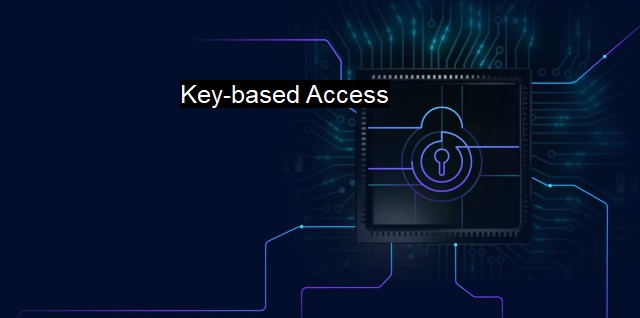What are Key-based Access?
The Importance of Key-Based Access in Cybersecurity: Protecting Confidential Information with Encryption Keys and Access Control Mechanisms
Key-based access is a method of access control commonly used in cybersecurity and antivirus protection scenarios to ensure secured access to data or system resources. Providing a more secure way to authenticate users, it involves the use of cryptographic keys, bypassing the susceptibility, and reducing threats associated with more traditional user/password access methods such as brute force and dictionary attacks.The basis of key-based access lies in cryptography, a technique for securing data by converting it into a format that can only be read by those who possess a particular cryptographic key. Cryptographic keys are essentially a string of characters that are used in combination with an algorithm to transform data into an unreadable format or back into a readable format.
Key-based access mainly operates in two modes: symmetric cryptography and asymmetric cryptography. In symmetric key cryptography, a single key is used for both encryption and decryption of data. For the recipient to decode the information, they should have the corresponding key. Given its simple nature, it is often faster compared to other cryptographic systems. the principal challenge lies in securely distributing the key to the recipient.
Asymmetric key cryptography, on the other hand, uses a pair of keys - a public key for encryption and a private key for decryption. The public key is openly shared while the private key is kept confidential. The use of different keys for encryption and decryption enhances security as the transmission of the encoded message does not pose a leak or compromise to the private key.
Key-based access in cybersecurity maintains many advantages. On top of secure communication, they ensure authenticity, non-repudiation, and confidentiality. Authenticity ensures that all parties participating in the communication are indeed who they claim to be. Non-repudiation prevents a sender from denying having sent a particular message—an essential feature in business and legal contexts. Confidentiality is maintained by enciphering the communication with keys to prevent unauthorized access.
In antivirus software or systems, the key-based access feature plays a significant role in preventing unauthorized system access. The antivirus encrypts a system's information, and access is only granted to parties that have a valid decryption key.
On the downside, key-based access systems have their challenges. Key management and distribution can be complicated, especially in symmetric systems. there is also the risk of key loss or theft, and there is a constant need to guard against possible vulnerabilities and maintain regular updates and fixes in the face of emerging and advanced threats.
In the realm of IoT (Internet of Things) devices and cloud-based systems, the importance of robust key-based access systems cannot be overstated. With the proliferation of these devices and rapid expansion of our digital activities, ensuring the secure exchange of information rests heavily on efficient and secure key-based access methods.
While user password security remains a widely opted authentication measure, the major drawbacks of this method—memory issues, simple passwords, and human errors— significantly undermine its efficacy as a secure authentication and access control method. Hence, key-based access affirms its importance and relevance in the dynamic and ever-evolving domain of cybersecurity and antivirus software. Its capacity to provide and maintain a high level of security, which traditional methods are hard-pressed to accomplish, further emphasizes its crucial role.
Regardless of the network, system or its size, managing and controlling access warrants serious attention and effective measures. Key-based access serves this requirement effectively, curbing unauthorized data access, safeguarding information, and ensuring secure communication, thereby enhancing cybersecurity.

Key-based Access FAQs
What is key-based access in cybersecurity?
Key-based access is a secure method of authentication for accessing data, systems or applications. It involves the use of cryptographic keys to confirm the identity of a user or device, rather than using a password or other traditional forms of authentication.How does key-based access work in antivirus software?
In antivirus software, key-based access can be used to authenticate the legitimacy of software updates or other components that are downloaded from remote servers. This approach helps to prevent unauthorized access to the antivirus application and ensures that the updates are coming from a trusted source.What are the benefits of using key-based access in cybersecurity?
Key-based access offers several benefits over traditional authentication methods, including increased security, improved scalability, and better control over access permissions. Additionally, because cryptographic keys are more difficult to compromise than passwords, they provide a higher level of assurance that only authorized users or devices are accessing sensitive data or resources.What are some best practices for implementing key-based access in cybersecurity?
To ensure the effectiveness of key-based access, it's important to follow best practices such as generating strong keys, rotating keys on a regular basis, encrypting keys in transit and at rest, and limiting the number of users or devices that have access to the keys. Additionally, key-based access should be combined with other security measures such as firewalls, intrusion detection systems, and antivirus software to provide layered protection against cyber attacks.| | A | | | B | | | C | | | D | | | E | | | F | | | G | | | H | | | I | | | J | | | K | | | L | | | M | |
| | N | | | O | | | P | | | Q | | | R | | | S | | | T | | | U | | | V | | | W | | | X | | | Y | | | Z | |
| | 1 | | | 2 | | | 3 | | | 4 | | | 7 | | | 8 | | |||||||